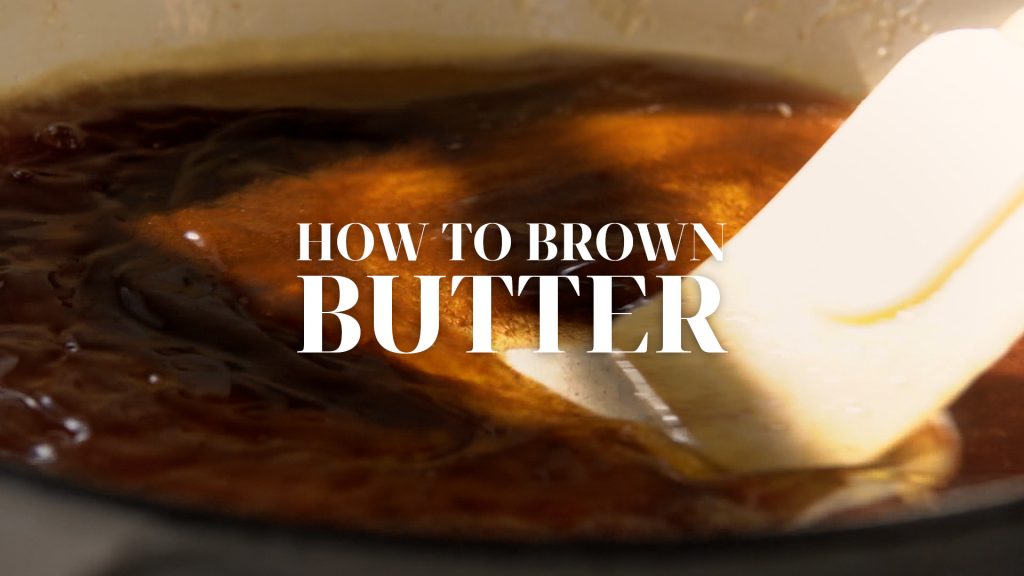Brown butter, where do we even begin? It’s a one-ingredient wonder with the power to elevate your bakes and savoury dishes from ‘meh’ to ‘hell yeah!’. Brown butter is made by cooking butter over the stovetop just long enough for the milk solids to caramelise. Aptly dubbed liquid gold or beurre noisette (French for ‘hazelnut butter’), brown butter adds an addictive nutty taste, toasty aroma and golden hue to food. Although it sounds fancy, there’s really nothing to it…all you’ll need to make your own is a frying pan, a few minutes of your time and, well, butter.
How to make brown butter
- MELT: Place diced butter in a large frying pan or pot. Use a lightly-coloured one if possible so that you can monitor the magical colour change. Gently heat the butter over low heat until it’s melted.
- EVAPORATE: In order to toast the milk solids, all the water in the butter needs to be cooked off. Continue to heat the butter, stirring gently with a silicone spatula. As the water evaporates, the butter will start to bubble and spatter dramatically, so be careful. Keep scraping down the base and sides of the pan with your spatula to prevent the milk solids from catching and burning.
- BROWN: After a few minutes, your butter will start to foam rapidly. Keep stirring the butter to keep the foam down, and if it’s rising too high, pull your frying pan off the heat to stop it from spilling over – this is also why using a large pan is important. Keep a watchful eye on the butter, as it will start to brown at this point. You’ll know the butter is done when your kitchen is filled with an intoxicating aroma, and you’re left with a rich, golden liquid speckled with brown bits.
How brown is brown?
Brown butter is not only simple to make, but it’s also incredibly versatile. The further you cook your brown butter (i.e. the darker the colour), the more intense the flavour will be. This makes it adaptable for both sweet and savoury applications.
Lightly browned for delicate dishes:
Remove the butter from the heat juuust as it takes on a golden brown colour. Subtle in flavour, light brown butter is best used in fresher, more delicate dishes. It’s delicious used in salad dressings in place of the oil, or drizzled over veggie dishes like boiled baby potatoes and roasted honey carrots.
Golden brown for e-very-thing:
This is the mothership of brown butter. It can be thrown into almost anything – your only limit is your imagination! Golden brown butter is most fondly used to make a sage & burnt butter sauce in which gnocchi or pasta are tossed. Use it to cook eggs or saute veg; brown butter green beans with flaked almonds is one of my fav sides. A drizzle of golden brown butter can elevate chicken, fish and cooked grains. Or you can brush some over warm bread rolls, toss it through muesli before baking…there are no rules!
Dark brown for bakes:
One trick I learnt from working in a commercial bakery is to take brown butter pretty far when using it in cakes, brownies and other ‘robust’ baked goods. Like until it’s borderline-black. Trust me: the other ingredients in the recipe will balance out the intense, smoky flavour. For more delicate bakes, like crepes, opt for golden brown butter as it’s less harsh in flavour.
Baking with brown butter
Brown butter is easier to experiment with in savoury dishes, but for baking, as always, things get a *touch* more technical.
Firstly, the loss of water in brown butter can affect the outcome of your bakes. Moisture is important for baking as it generates steam; this, in turn, creates texture and rise. To add moisture back into your brown butter, drop an ice cube into the hot liquid when it’s ready; it will also bring down the temperature of your butter to stop any residual cooking. Be careful, as it may sputter.
For baking, substitute brown butter one-for-one in recipes that call for melted butter or oil – just make sure it has cooled to room temperature first. This includes brownies, banana bread, muffins, and cookies. Try out our cherry, almond & brown butter cake or this rosemary, brown butter and cracked black pepper soda bread. Because of evaporation, you’ll end up with less brown butter than the amount of butter you started with, so always brown more butter than the recipe requires (e.g. if you’re substituting 100g melted butter, brown 120g butter). If you’re still a little short on brown butter, top it up with oil or melt in an extra knob of butter.
Store any leftover brown butter in the fridge, where it’ll firm up into a solid. Spread it into crepes with a drizzle of honey, or enjoy on a slice of avo toast. Solid brown butter can also be creamed into cakes and biscuits or even incorporated into the buttercream. As a general rule, only replace half (or part of) the total butter with solid brown butter, like in these brown butter cookies with caramelised white chocolate.
To make sure you always have brown butter on hand, make a big batch and store it in a jar in the fridge – use it as is, or quickly melt it into liquid form.
SEE ALSO: How to make cold brew coffee


